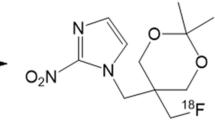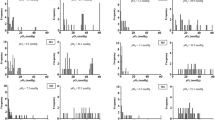Abstract
18F-FRP170, 1-(2-fluoro-1-[hydroxymethyl]ethoxy)methyl-2-nitroimidazole, is a new hypoxia imaging agent for positron emission tomography. This compound was synthesized by18F-labeling of RP170, which was developed as a new hydrophilic 2-nitroimidazole analog. In the present study, we analyzed dynamic whole-body imaging in healthy volunteers and dynamic tumor imaging in three patients with lung cancer.Methods: Four healthy male volunteers and three lung cancer patients were enrolled in this study. Volunteers underwent dynamic whole-body scans just after injection of18F-FRP170 for about 90 min, while the lung cancer patients underwent dynamic tumor imaging for about 60 or 120 min. Data are expressed as standardized uptake values (SUV). Regions of interest were placed over images of each organ or tumor to generate time-SUV curves.Results: The series of dynamic whole-body scans showed rapid elimination of18F-FRP170 from the kidneys following elimination from the liver. Very low physiological uptake was observed above the diaphragm.18F-FRP170 uptake in the lung cancer lesion could be visualized clearly from early after injection. The changes of tumor SUV, tumor/blood ratio, or tumor/muscle ratio about 30 min after injection or later were small.Conclusions: Dynamic imaging using18F-FRP170 demonstrated rapid elimination from the kidney, suggesting the high hydrophilicity of this imaging agent. The background activity above the diaphragm was very low, and patients with lung cancer showed clear tumor uptake of18F-FRP170 early after injection.
Similar content being viewed by others
References
Nunn A, Linder K, Strauss HW. Nitroimidazoles and imaging hypoxia.Eur J Nucl Med 1995; 22: 265–280.
Chapman JD, Franko AJ, Sharplin J. A marker for hypoxic cells in tumours with potential clinical applicability.Br J Cancer 1981; 43: 546–550.
Koh WJ, Bergman KS, Rasey JS, Peterson LM, Evans ML, Graham MM, et al. Evaluation of oxygenation status during fractionated radiotherapy in human nonsmall cell lung cancers using [F-18]fluoromisonidazole positron emission tomography.Int J Radiat Oncol Biol Phys 1995; 33: 391–398.
Rasey JS, Koh WJ, Evans ML, Peterson LM, Lewellen TK, Graham MM, et al. Quantifying regional hypoxia in human tumors with positron emission tomography of [18F]fluoromisonidazole: a pretherapy study of 37 patients.Int J Radiat Oncol Biol Phys 1996; 36: 417–428.
Sasai K, Shibamoto Y, Takahashi M, Abe M, Wang J, Zhou L, et al. A new, potent 2-nitroimidazole nucleoside hypoxic cell radiosensitizer, RP170.Jpn J Cancer Res 1989; 80: 1113–1118.
Murayama C, Suzuki A, Sato C, Tanabe Y, Miyata Y, Shoji T, et al. Radiosensitization by 2-nitroimidazole nucleoside analog RP-170: radiosensitizing effects under both intravenous and oral administration.Int J Radiat Oncol Biol Phys 1992; 22: 557–560.
Murayama C, Suzuki A, Suzuki T, Miyata Y, Sakaguchi M, Tanabe Y, et al. Radiosensitization by a new nucleoside analogue: 1-[2-hydroxy-1-(hydroxymethyl)ethoxy]methyl-2-nitroimidazole (RP-170).Int J Radiat Oncol Biol Phys 1989; 17: 575–581.
Yang DJ, Wallace S, Cherif A, Li C, Gretzer MB, Kim EE. et al. Development of F-18-labeled fluoroerythronitroimidazole as a PET agent for imaging tumor hypoxia.Radiology 1995; 194: 795–800.
Wada H, Iwata R, Ido T, Takai Y. Synthesis of 1-[2-[18F]fluoro-1-(hydroxymethyl)-ethoxy]methyl-2-nitroimidazole ([18F]FENI), a potential agent for imaging hypoxic tissues by PET.J Label Compd Radiopharm 2000; 43: 785–793.
Kaneta T, Takai Y, Kagaya Y, Yamane Y, Wada H, Yuki M, et al. Imaging of ischemic but viable myocardium using a new18F-labeled 2-nitroimidazole analog,18F-FRP170.J Nucl Med 2002; 43: 109–116.
Fujiwara T, Watanuki S, Yamamoto S, Miyake M, Seo S, Itoh M, et al. Performance evaluation of a large axial field-of-view PET scanner: SET-2400W.Ann Nucl Med 1997; 11: 307–313.
Brown JM, Workman P. Partition coefficient as a guide to the development of radiosensitizers which are less toxic than misonidazole.Radiat Res 1980; 82: 171–190.
Barthel H, Wilson H, Collingridge DR, Brown G, Osman S, Luthra SK, et al.In vivo evaluation of [18F]fluoroetanidazole as a new marker for imaging tumour hypoxia with positron emission tomography.Br J Cancer 2004; 90: 2232–2242.
Rasey JS, Hofstrand PD, Chin LK, Tewson TJ. Characterization of [18F]fluoroetanidazole, a new radiopharmaceutical for detecting tumor hypoxia.J Nucl Med 1999; 40: 1072–1079.
Kumar P, Stypinski D, Xia H, McEwan A, Machulla H, Wiebe LI. Fluoroazomycin arabinoside (FAZA): Synthesis,2H and3H-labelling and preliminary biological evaluation of a novel 2-nitroimidazole marker of tissue hypoxia.J Label Compd Radiopharm 1999; 42: 3–16.
Piert M, Machulla HJ, Picchio M, Reischl G, Ziegler S, Kumar P, et al. Hypoxia-specific tumor imaging with18F-fluoroazomycin arabinoside.J Nucl Med 2005; 46: 106–113.
Eschmann SM, Paulsen F, Reimold M, Dittmann H, Welz S, Reischl G, et al. Prognostic impact of hypoxia imaging with18F-misonidazole PET in non-small cell lung cancer and head and neck cancer before radiotherapy.J Nucl Med 2005; 46: 253–260.
Lehtio K, Eskola O, Viljanen T, Oikonen V, Gronroos T, Sillanmaki L, et al. Imaging perfusion and hypoxia with PET to predict radiotherapy response in head-and-neck cancer.Int J Radiat Oncol Biol Phys 2004; 59: 971–982.
Ishikawa Y, Funaki Y, Iwata R, Furumoto S, Nakata E, Kudo Y, et al. [Development of [18F]FRP-170 injection for imaging hypoxia by PET].KAKU IGAKU (Jpn J Nucl Med) 2005; 42: 1–10.
Graziano MJ, Henck JW, Meierhenry EF, Gough AW. Neurotoxicity of misonidazole in rats following intravenous administration.Pharmacol Res 1996; 33: 307–318.
Rajendran JG, Wilson DC, Conrad EU, Peterson LM, Bruckner JD, Rasey JS, et al. [(18)F]FMISO and [(18)F]FDG PET imaging in soft tissue sarcomas correlation of hypoxia, metabolism and VEGF expression.Eur J Nucl Med Mol Imaging 2003; 30: 695–704.
Author information
Authors and Affiliations
Corresponding author
Rights and permissions
About this article
Cite this article
Kaneta, T., Takai, Y., Iwata, R. et al. Initial evaluation of dynamic human imaging using18F-FRP170 as a new PET tracer for imaging hypoxia. Ann Nucl Med 21, 101–107 (2007). https://doi.org/10.1007/BF03033987
Received:
Accepted:
Issue Date:
DOI: https://doi.org/10.1007/BF03033987




